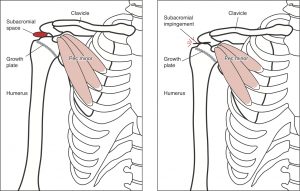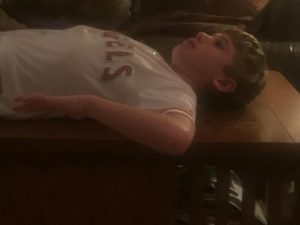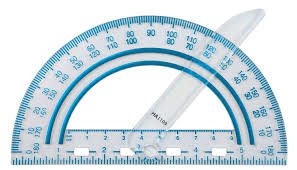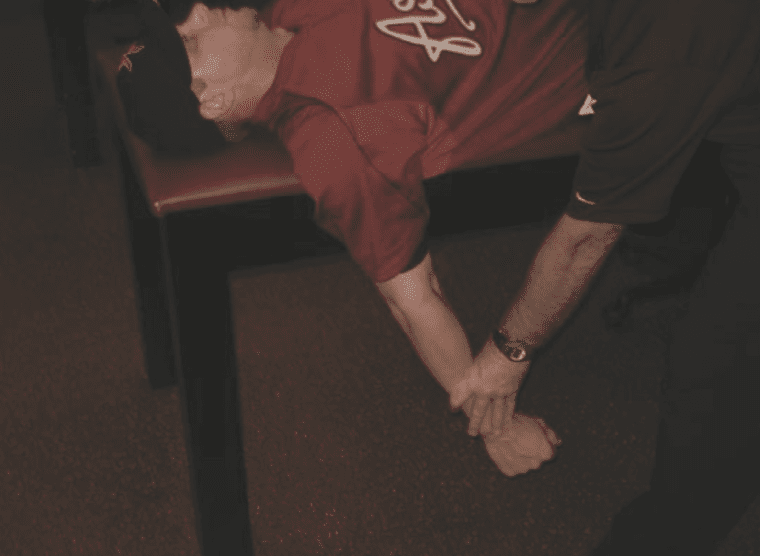Bring me a case of a kids shoulder pain, and I will l likely figure out the cause pretty quickly.
Doesn’t matter if they are a volleyball hitter, baseball pitcher, swimmer, or tennis player.
Unless there was some kind of accident where the shoulder came out (or almost came out) of joint, kids shoulder pain tends to have a common flavor.
Before moving on, do realize that the causes of kids shoulder pain tend to be different than adults:
- Children do not tend to tear rotator cuff muscles
- Kids do not get bone spurs
Now we have that straight, then let’s answer the question.
Why does a kids shoulder tend to hurt?
The shoulder is actually not one joint, it is really three different joints:
- The connection between the collarbone (clavicle) and the shoulder girdle (scapula)
- The connection between the shoulder girdle (scapula) and the rib cage
- The “ball and socket” joint between the shoulder girdle and humerus bone
- What most people think of when speaking about shoulder joints
Kids shoulder pain tends to be from a problem with one, two or even all three of these connections.
Some simple exam points and measurements can discover these problems and help with fixing the causes of kids shoulder pain.
Kids Shoulder Pain Problem 1: Narrow space under the collarbone/shoulder girdle joint
Tightness of muscles in the front of the chest can pull the shoulder girdle downward, reducing the space where some important other muscles work.
These muscles include the supraspinatous, which is important in starting a throwing or hitting motion.
- I tend measure the pain level when pushing on a bone region on the shoulder girdle called the coracoid.
If the kid jumps or winces when I find the coracoid, I can imagine that the supraspinatous is not real happy either.
A painful coracoid means that the space under the collarbone is narrowed, pinching the supraspinatous, leading to kids shoulder pain.
Narrowing of this space is found in adults (commonly due to those bone spurs) but in kids, it is a muscle tightness thing.
This tightness can also put additional pressure on the growth plate at the top of the humerus bone.
Work on stretching the muscles in the front of the chest, and that kids shoulder pain just might get better.
Kids Shoulder Pain Problem 2: The shoulder girdle is down and out
If you are around my age, you probably remember the movie “Down and Out in Beverly Hills”.
Today’s kids are too young to remember it, and their “down and out” experience usually is with a painful shoulder.
The shoulder blade is the foundation for any hitting or throwing motion.
Proper position of the shoulder blade on top of the rib cage is essential for proper shoulder muscle control and function.
Often, the improper position is to have the shoulder blade lower and further from the center of the back.
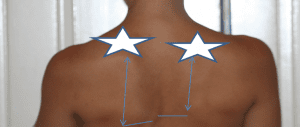
STAR: top of the shoulder blade
BLUE HORIZONTAL LINE: distance from shoulder blade to the spine
- I pull out my ruler and measure the differences between the shoulders.
This improper position not only creates a higher risk for muscle injury, but can also lead to damage of the labrum, which is the pad between the shoulder ball and socket joint.
Specific exercises that put the shoulder blade back to a more effective position can lead to less kids shoulder pain and better performance.
Kids Shoulder Pain Problem 3: Limited follow through at the ball and socket joint
Starting a throw or hit puts the shoulder in external rotation.
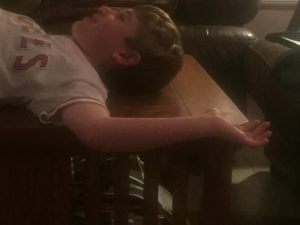
External Rotation
Finishing a throw or hit (the follow through) puts the shoulder in internal rotation.
Most kids who are good at throwing or hitting have plenty of external rotation.
It is the lack of internal rotation that tends to be a problem.
Limited internal rotation are due to tightness of the muscles and tissues that form the back of the ball and socket shoulder joint.
Reduced internal rotation puts pressure not only on the shoulder muscles and labrum pad, but also on the inside of the elbow.
More Info: Sorting out causes of elbow pain in young throwers
In fact, most of my kids with elbow pain have really limited internal rotation of their shoulders.
I see limited internal rotation so often that I’m known as the old-school doctor who carries a protractor.
My patients who study geometry know what a protractor is, those who don’t learn real quick.
- Protractors measure angles, and I compare the external and internal rotation angles of both shoulders.
Stretching exercises can reduce tightness in the front of the shoulder and also increase internal rotation.
Houston Astro Stretching Program
Click here to see the Houston Astro Stretching Program.
Summing up Kids Shoulder Pain
Once I explain the causes and make a treatment plan, I tell kids that I will repeat my findings and measurements at follow-up visits.
Having numbers makes it easier for me to determine if a kid is doing their homework.
It also should motivate the athlete, since they know exactly what I will be checking down the road.
If they are doing their exercises, their measurements should be better, and their pain should be lower.
Related Video Content: Importance of accurate diagnosis and step-wise return to play after injury


